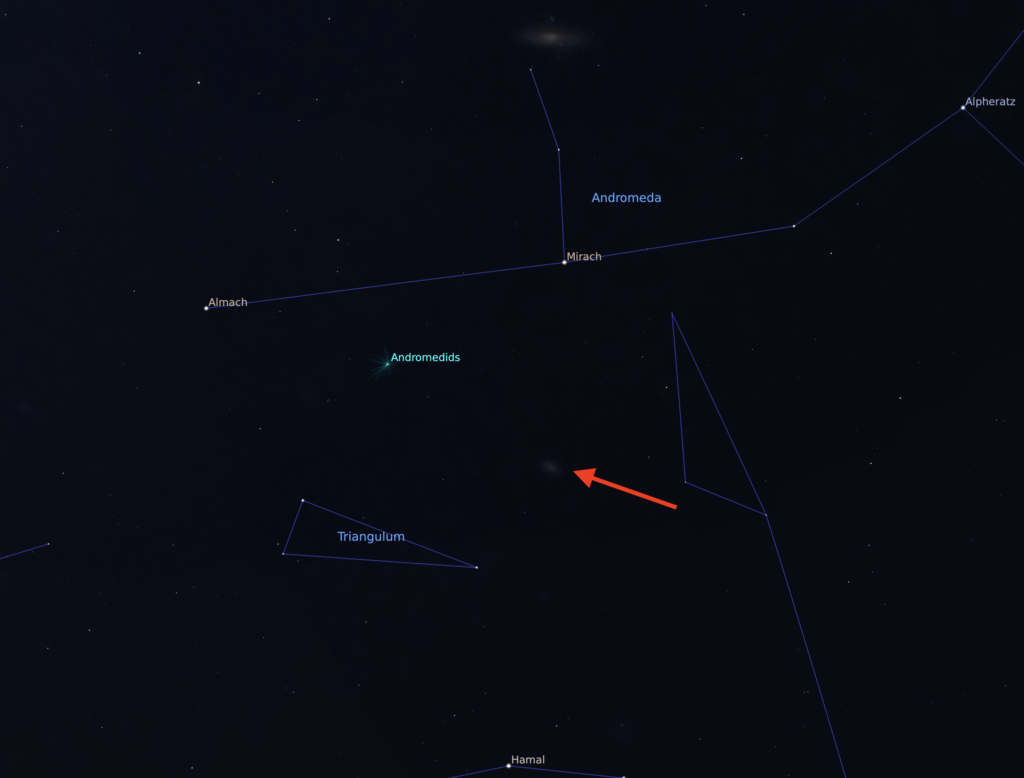The Triangulum Galaxy, also known as Messier 33 (M33), is a stunning spiral galaxy located in the constellation Triangulum.
For centuries, astronomers and enthusiasts have marveled at its celestial beauty, and in this comprehensive guide, we will explore the step-by-step process of finding, observing, and appreciating the Triangulum Galaxy. From optimal viewing times to telescope recommendations and star hopping techniques, let’s embark on a cosmic journey.
What is the Triangulum Galaxy?
The Triangulum Galaxy, also known as Messier 33 (M33), is a spiral galaxy located in the constellation Triangulum. It is the third-largest galaxy in our Local Group, with a diameter of about 60,000 light-years, making it roughly half the size of our Milky Way. Positioned approximately 3 million light-years away from Earth, the Triangulum Galaxy is characterized by its intricate spiral arms and is a member of the Triangulum subgroup within the larger Andromeda Galaxy group.
Want to get started in astronomy?
Our free telescope cheat sheet breaks down the key factors to choosing a telescope and shows you how to get stunning views of planets, nebula, and galaxies!

Optimal Viewing Times in the Northern Hemisphere
The Triangulum Galaxy is best observed in the late autumn and early winter months when the constellation Triangulum ascends to its highest point in the night sky.
Late Autumn (October)
As October unfolds, the constellation Triangulum rises in the northeastern sky. During the early part of the month, observers can start looking for the distinctive triangular shape of the constellation, laying the foundation for Triangulum Galaxy observations. Around midnight, Triangulum becomes more prominent, making it visible for stargazers.
Early Winter (November)
Triangulum takes center stage in November, reaching its highest point in the sky during the late evening and early morning hours. Around midnight, the constellation is positioned nearly overhead, providing an ideal vantage point for Triangulum Galaxy observations. This alignment minimizes atmospheric interference, allowing for clearer views.
Midwinter (December)
December continues to be a prime month for Triangulum Galaxy observations. Triangulum remains visible, and the longer nights provide extended opportunities for stargazing. Around midnight, when Triangulum is at its zenith, the Triangulum Galaxy beckons with enhanced clarity and detail.
Early Spring (January)
Although Triangulum begins its descent in early spring, January still offers excellent chances for Triangulum Galaxy viewing. The constellation remains well-placed for observation around midnight, gradually transitioning towards the western horizon as the night progresses.
Considerations for Each Month
- October: Initiate your observation sessions in the latter part of the night as Triangulum becomes visible, progressively extending your stargazing duration.
- November: The peak of Triangulum’s visibility around midnight offers an optimal time frame for capturing the Triangulum Galaxy’s intricate features.
- December: Enjoy extended stargazing sessions, taking advantage of Triangulum’s high position in the sky during the late evening and early morning.
- January: While Triangulum begins its descent, early to mid-January remains favorable for Triangulum Galaxy observations, especially in the first half of the night.

Can you see the Triangulum Galaxy with the naked eye?
The Triangulum Galaxy can be seen with the naked eye under the right conditions.
Despite being a member of our cosmic neighborhood, approximately 2.7 million light-years away, the Triangulum Galaxy, also known as Messier 33 (M33), can reveal its celestial secrets without the aid of telescopic lenses. To witness this remarkable sight without the constraints of optical instruments, pristine dark skies far from the pervasive glow of urban lights are essential.
Light pollution, caused by artificial lighting, dims the brilliance of celestial objects. In areas with minimal light pollution, the Triangulum Galaxy emerges as a faint, misty patch in the sky. Observers fortunate enough to venture into remote locations, away from the glare of city lights, can experience the naked-eye spectacle of this spiral beauty. I still typically prefer to have at least binoculars even under pretty dark skies,
It’s important to note that while the Triangulum Galaxy’s apparent magnitude is relatively bright (approximately 5.7), its extensive size and low surface brightness make it a challenging target for naked-eye observers. Patience and perseverance are key virtues, as the galaxy may appear as a faint, diffuse patch in the sky. Additionally, using averted vision—a technique where the observer looks slightly away from the object—can enhance the visibility of the Triangulum Galaxy.
Even with a decent size telescope such as an 8 inch reflector, you may still struggle to find the galaxy especially under skies with some light pollution. So just remember that patience is key when it comes to the Triangulum Galaxy.
Star Hopping Techniques to find the Triangulum Galaxy
Find the elusive Triangulum Galaxy using this star hopping technique:
1. Identify Andromeda Galaxy: Begin your cosmic exploration by locating the well-known Andromeda Galaxy (M31). As one of the nearest spiral galaxies to our own Milky Way, Andromeda serves as an excellent starting point in the autumn night sky. This stunning galaxy can be spotted with the naked eye under dark skies, resembling a faint smudge of light.
2. Find Mirach (Beta Andromedae): To guide your way, look for the star Mirach (Beta Andromedae), located in the constellation Andromeda. This star, often referred to as “Beta And,” is part of the distinctive constellation’s pattern.
4. Navigate to Triangulum: Now, shift your focus from Andromeda towards the neighboring constellation Triangulum. Follow an imaginary line from Mirach to the brightest star in Triangulum, Alpha Trianguli (α Tri). This star, also known as Mothallah, serves as a key marker.
6. Spot the Triangulum Galaxy: With Mothallah as your guide, center your attention on the line between Mothallah and Mirach. The Triangulum Galaxy (M33) Will be on your way from Mothallah when you get about 35% to 40% of the way to Mirach, off to the right or left, depending on your scope.
HIP 7906/HD 10348/SAO 74872 is a six magnitude star located on the way from Mothallah that can get you closer if you need extra guidance.
Initially appearing as a faint smudge or patch, the galaxy’s intricate details will gradually reveal themselves with continued observation.

Final word
As you practice this star hopping technique, the Triangulum Galaxy will become a familiar celestial companion in your stargazing repertoire. Let the wonders of the night sky unfold, and may your cosmic adventures be filled with awe and discovery.
Embark on your celestial adventure to discover the beauty of the Triangulum Galaxy, and may your nights be filled with awe and wonder as you explore the vastness of our cosmic neighborhood. Happy stargazing!
Feature photo: NASA/JPL-Caltech – http://photojournal.jpl.nasa.gov/gallery/universe?subselect=Target:M33







